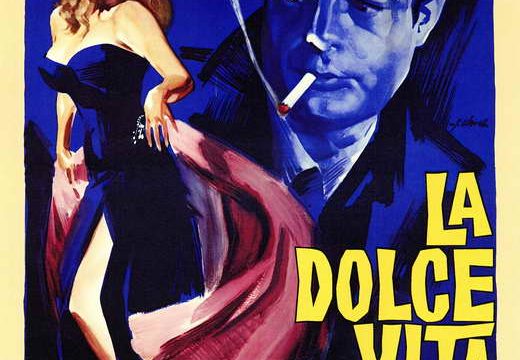Douglas Laman is looking at all the movies on the Sight & Sound’s 50 Greatest Move lists that he has never seen before!
Sight & Sound Voyage Entry #11
Placement On Sight & Sound Top 50 Movies List: #39
And now it is time once again for me to discover another hugely influential filmmaker whose work I’ve somehow been totally ignorant of until now. This time, it’s Federico Fellini, the Italian writer/director behind a number of the most acclaimed motion pictures of all-time. It is his 1960 movie La Dolce Vita that serves as my introduction to this man’s work, and after viewing La Dolce Vita, I can say that I am ravenous for other pieces of Federico Fellini’s filmmaker. Good Lord, this guy has an incredible skill as a filmmaker, something incredibly evident from his work here in La Dolce Vita.
The premise within La Dolce Vita is an intriguing beast, one that’s split into various misadventures that each star Marcello (Marcello Mastroianni), a journalist whose marriage is a shambling mess and whose entire life consists of him getting into various parties and escapades. In one plotline, for instance, he becomes infatuated with a famous American movie star while another see’s him briefly reuniting with his estranged father. Yet another see’s him spending the night at a haunted house where he runs into an old flame. Sexually vicarious women frequently permeate these stories while the parties he goes to seem to get gradually crazier and crazier.
It’s an odd storytelling structure to explain in the format of a plot summary usually used to recount the plots of films with traditional three-act structures, but believe me when I say that La Dolce Vita uses that unorthodox storytelling style to excellent results. There’s a lot to pack in terms of the underlying themes of the movie, but one primary trait of its entire being reminded me of, of all things, notable cable sitcom It’s Always Sunny Philadephia. No, I’m not joking. La Dolce Vita very much struck me as like an Italian feature-length version of an episode of It’s Always Sunny In Philadelphia in that it’s all about selfish jerks who put their self-centered needs first, typically making themselves looking uber pathetic in the process. This is especially applicable in the final sequence wherein a woman whose husband just murdered their children and himself is at the center of a joyful party dedicated to her newfound freedom.
Leading an extended cast of self-absorbed scoundrels is Marcello, who most certainly fits right into the debauchery he surrounds himself in. The way he constantly immerses himself in the world of extended parties and crudeness leads into another notable concept constantly thrown around in La Dolce Vita, which is examining the darker undercurrent found in typically idyllic entities. For instance, the nuclear family (the gold standard for “You’ve made it in society” in the mid-20th century) is shown to be more of a curse more than anything else for a father while a famous American actress (who’s an obvious Marilyn Monroe pastiche) leads a life of luxury and seeming bliss…except she’s got a physically abusive boyfriend. Even Italy itself, a land typically depicted in postcards as a place of romance and wonder, can’t remove the main protagonists romantic troubles with his wife and the empty feeling in his soul he tries to fill with partying and women.
There’s a swirling vortex of soul-crushing despair in the center of La Dolce Vita and it’s a vortex that soaks in the protagonist of the movie, Marcello. Marcello would like to think of himself as a carefree ladies man journalist, but it’s clear from any given scene of La Dolce Vita that he’s really just more pathetic than anything else, a man who tries to compensate for his barren interior by putting on an exterior face that thrives on debauchery. It’s a wonder following him for nearly three hours doesn’t get repetitive but the characters insistence of trying to fill out his life with all kinds of partying and excess do lend themselves an intentionally riveting tragic quality to them akin to watching a trainwreck in real time.
Having the story be comprised of various escapades Marcello gets into helps keep the movies plot moving in at a solid pace, there’s always some new location or degeneracy to witness. Why, in the last forty minutes of La Dolce Vita alone, the audience is privy to parties at both a haunted house and a smaller-scale houseparty, both of which are filled to the brim with memorable activities.There’s no stagnation to be found in the way the plot is structured because if Marcello (or other supporting characters like the always present paparazzo) stop to contemplate the emptiness of their own lives for even one second, they may drown in despair. Really, this incredibly thoughtful movie just moves at such a kinetic pace that its 174-minute running time flies by in the blink of an eye. Time flies when you’re watching phenomenal cinema I suppose!
At the helm of all this dissipation is, of course, Federico Fellini, I’d heard an insane amount of hype over this guy for years but watching one of his works for the first time made me sincerely believe he’s been, if anything, underrated in conversations revolving around his talent. There’s a remarkable craftsmanship even just in the way characters are arranged in certain shots let alone in how certain camera angles and specific types of shots are utilized for certain sequences. The multiple layers of detail found in the script are reinforced by the similar level of detail found in the directing, which has Fellini delivering top-caliber work that leaves you puzzling and puzzling until your puzzler is sore. La Dolce Vita was my introduction to this man’s work and the absolutely tremendous quality on display here ensures it will be far from the last movie of his that I watch.

